Auditing and Professional Practice: Account Selection
VerifiedAdded on 2020/05/16
|10
|1819
|176
Report
AI Summary
This report delves into the core aspects of auditing and professional practice, commencing with an overview of audit planning and the significance of analytical review. The report emphasizes the preliminary judgment of materiality, which guides the audit process. It then proceeds to dissect five key accounts: Cash at Bank, Gross Profit, Wages, Depreciation on Motor Vehicle, and Inventory. For each account, the report provides a rationale for selection, outlines the relevant assertions, and recommends specific audit procedures. The analysis includes the risks associated with each account, such as fraud, misstatement, and the impact on financial statements. The report concludes with a reference section, citing the sources used to support the analysis and recommendations. This report is a valuable resource for students and professionals seeking to understand the practical application of auditing principles.

Running head: AUDITING AND PROFESSIONAL PRACTICE
Auditing and professional practice
Name of the student
Name of the university
Author note
Auditing and professional practice
Name of the student
Name of the university
Author note
Paraphrase This Document
Need a fresh take? Get an instant paraphrase of this document with our AI Paraphraser
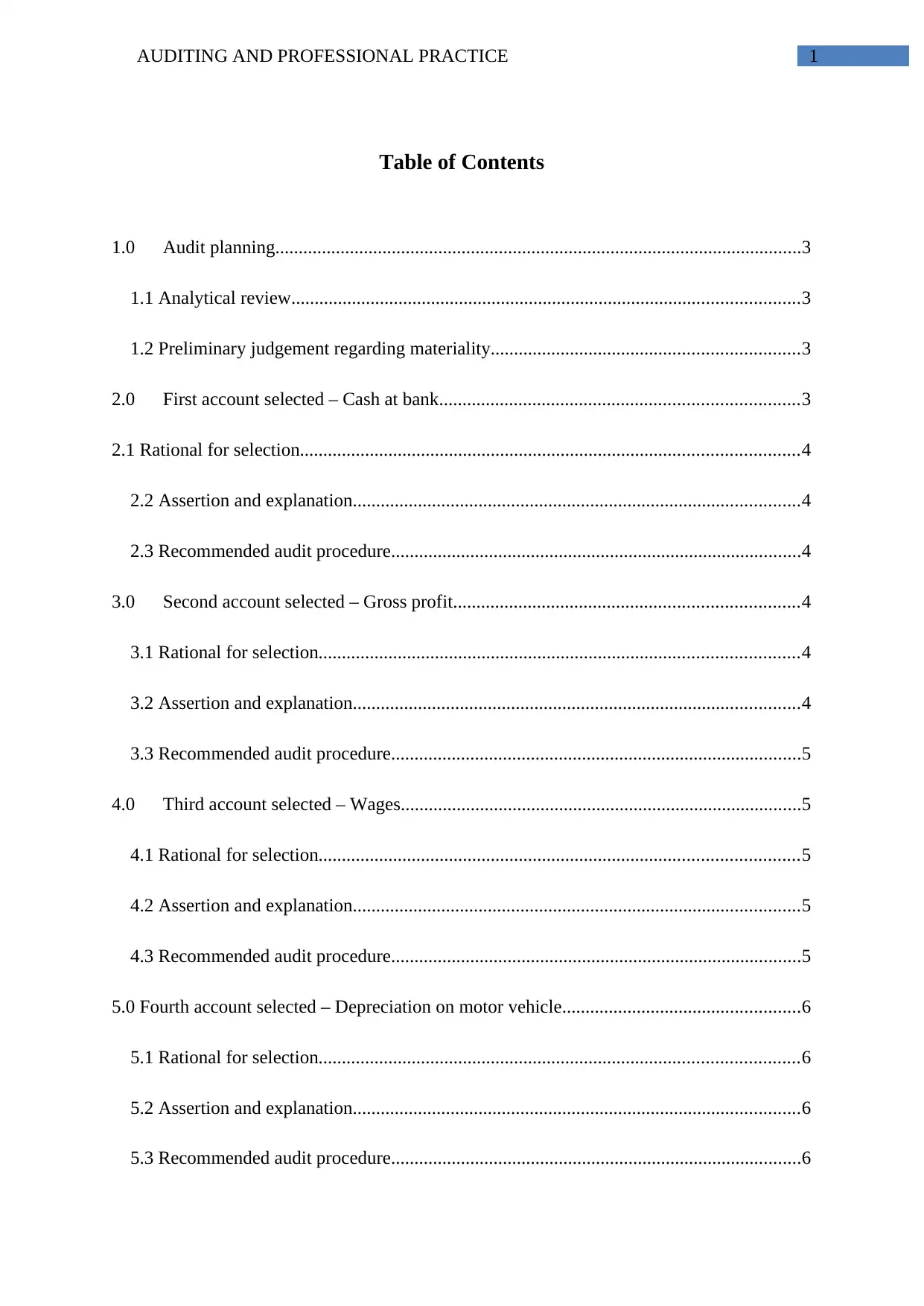
AUDITING AND PROFESSIONAL PRACTICE 1
Table of Contents
1.0 Audit planning.................................................................................................................3
1.1 Analytical review.............................................................................................................3
1.2 Preliminary judgement regarding materiality..................................................................3
2.0 First account selected – Cash at bank.............................................................................3
2.1 Rational for selection...........................................................................................................4
2.2 Assertion and explanation................................................................................................4
2.3 Recommended audit procedure........................................................................................4
3.0 Second account selected – Gross profit..........................................................................4
3.1 Rational for selection.......................................................................................................4
3.2 Assertion and explanation................................................................................................4
3.3 Recommended audit procedure........................................................................................5
4.0 Third account selected – Wages......................................................................................5
4.1 Rational for selection.......................................................................................................5
4.2 Assertion and explanation................................................................................................5
4.3 Recommended audit procedure........................................................................................5
5.0 Fourth account selected – Depreciation on motor vehicle...................................................6
5.1 Rational for selection.......................................................................................................6
5.2 Assertion and explanation................................................................................................6
5.3 Recommended audit procedure........................................................................................6
Table of Contents
1.0 Audit planning.................................................................................................................3
1.1 Analytical review.............................................................................................................3
1.2 Preliminary judgement regarding materiality..................................................................3
2.0 First account selected – Cash at bank.............................................................................3
2.1 Rational for selection...........................................................................................................4
2.2 Assertion and explanation................................................................................................4
2.3 Recommended audit procedure........................................................................................4
3.0 Second account selected – Gross profit..........................................................................4
3.1 Rational for selection.......................................................................................................4
3.2 Assertion and explanation................................................................................................4
3.3 Recommended audit procedure........................................................................................5
4.0 Third account selected – Wages......................................................................................5
4.1 Rational for selection.......................................................................................................5
4.2 Assertion and explanation................................................................................................5
4.3 Recommended audit procedure........................................................................................5
5.0 Fourth account selected – Depreciation on motor vehicle...................................................6
5.1 Rational for selection.......................................................................................................6
5.2 Assertion and explanation................................................................................................6
5.3 Recommended audit procedure........................................................................................6
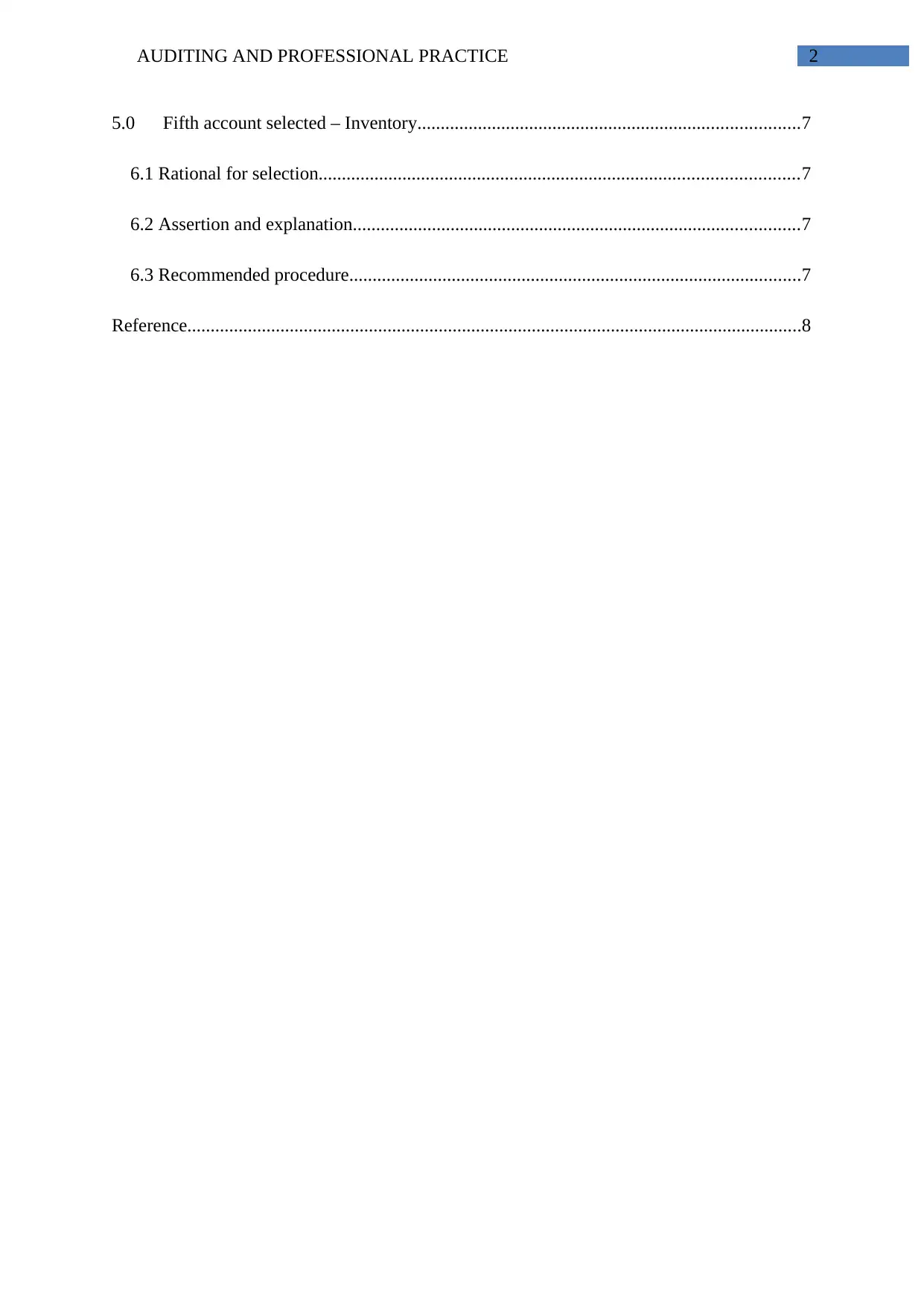
AUDITING AND PROFESSIONAL PRACTICE 2
5.0 Fifth account selected – Inventory..................................................................................7
6.1 Rational for selection.......................................................................................................7
6.2 Assertion and explanation................................................................................................7
6.3 Recommended procedure.................................................................................................7
Reference....................................................................................................................................8
5.0 Fifth account selected – Inventory..................................................................................7
6.1 Rational for selection.......................................................................................................7
6.2 Assertion and explanation................................................................................................7
6.3 Recommended procedure.................................................................................................7
Reference....................................................................................................................................8
⊘ This is a preview!⊘
Do you want full access?
Subscribe today to unlock all pages.

Trusted by 1+ million students worldwide
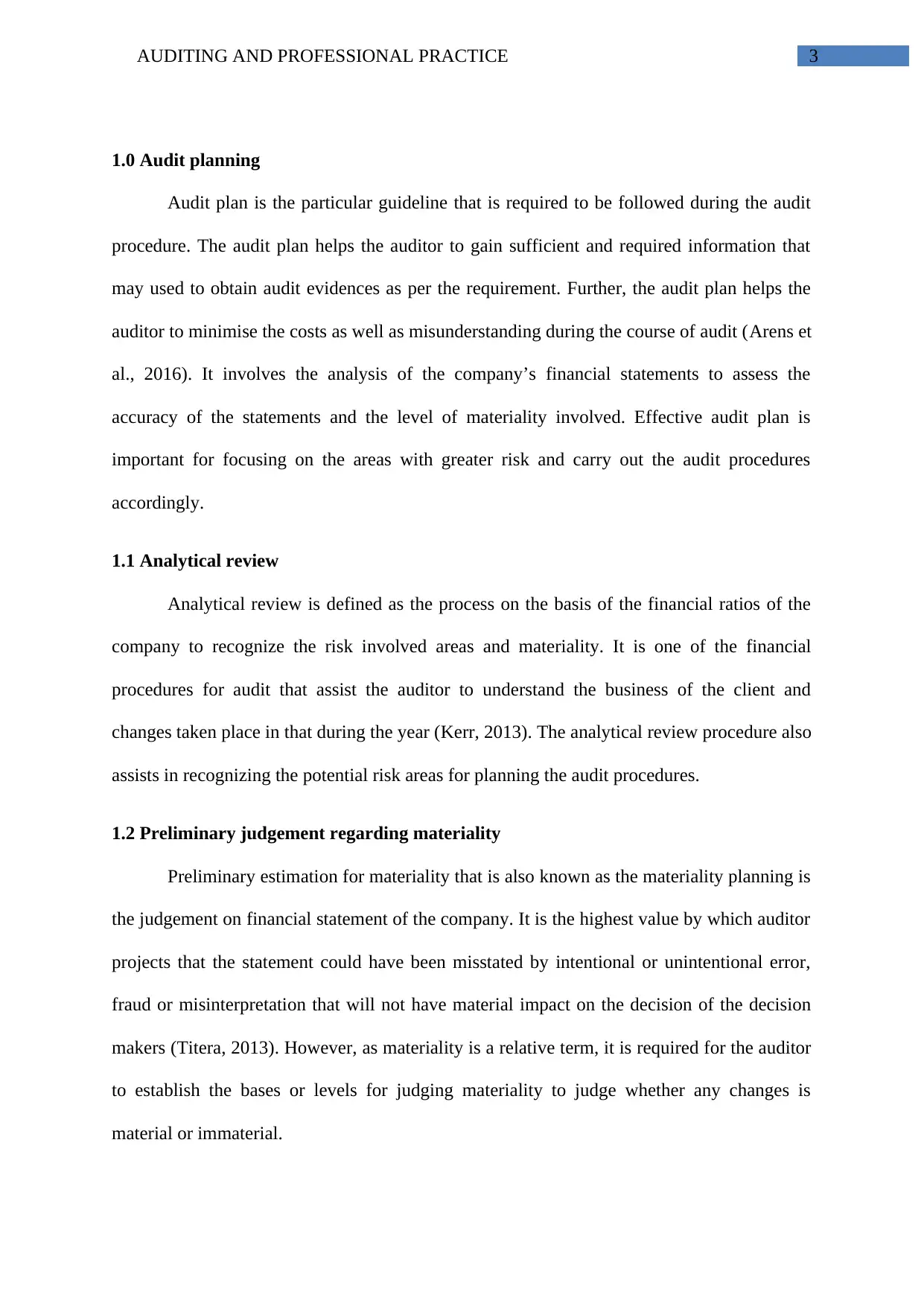
AUDITING AND PROFESSIONAL PRACTICE 3
1.0 Audit planning
Audit plan is the particular guideline that is required to be followed during the audit
procedure. The audit plan helps the auditor to gain sufficient and required information that
may used to obtain audit evidences as per the requirement. Further, the audit plan helps the
auditor to minimise the costs as well as misunderstanding during the course of audit (Arens et
al., 2016). It involves the analysis of the company’s financial statements to assess the
accuracy of the statements and the level of materiality involved. Effective audit plan is
important for focusing on the areas with greater risk and carry out the audit procedures
accordingly.
1.1 Analytical review
Analytical review is defined as the process on the basis of the financial ratios of the
company to recognize the risk involved areas and materiality. It is one of the financial
procedures for audit that assist the auditor to understand the business of the client and
changes taken place in that during the year (Kerr, 2013). The analytical review procedure also
assists in recognizing the potential risk areas for planning the audit procedures.
1.2 Preliminary judgement regarding materiality
Preliminary estimation for materiality that is also known as the materiality planning is
the judgement on financial statement of the company. It is the highest value by which auditor
projects that the statement could have been misstated by intentional or unintentional error,
fraud or misinterpretation that will not have material impact on the decision of the decision
makers (Titera, 2013). However, as materiality is a relative term, it is required for the auditor
to establish the bases or levels for judging materiality to judge whether any changes is
material or immaterial.
1.0 Audit planning
Audit plan is the particular guideline that is required to be followed during the audit
procedure. The audit plan helps the auditor to gain sufficient and required information that
may used to obtain audit evidences as per the requirement. Further, the audit plan helps the
auditor to minimise the costs as well as misunderstanding during the course of audit (Arens et
al., 2016). It involves the analysis of the company’s financial statements to assess the
accuracy of the statements and the level of materiality involved. Effective audit plan is
important for focusing on the areas with greater risk and carry out the audit procedures
accordingly.
1.1 Analytical review
Analytical review is defined as the process on the basis of the financial ratios of the
company to recognize the risk involved areas and materiality. It is one of the financial
procedures for audit that assist the auditor to understand the business of the client and
changes taken place in that during the year (Kerr, 2013). The analytical review procedure also
assists in recognizing the potential risk areas for planning the audit procedures.
1.2 Preliminary judgement regarding materiality
Preliminary estimation for materiality that is also known as the materiality planning is
the judgement on financial statement of the company. It is the highest value by which auditor
projects that the statement could have been misstated by intentional or unintentional error,
fraud or misinterpretation that will not have material impact on the decision of the decision
makers (Titera, 2013). However, as materiality is a relative term, it is required for the auditor
to establish the bases or levels for judging materiality to judge whether any changes is
material or immaterial.
Paraphrase This Document
Need a fresh take? Get an instant paraphrase of this document with our AI Paraphraser
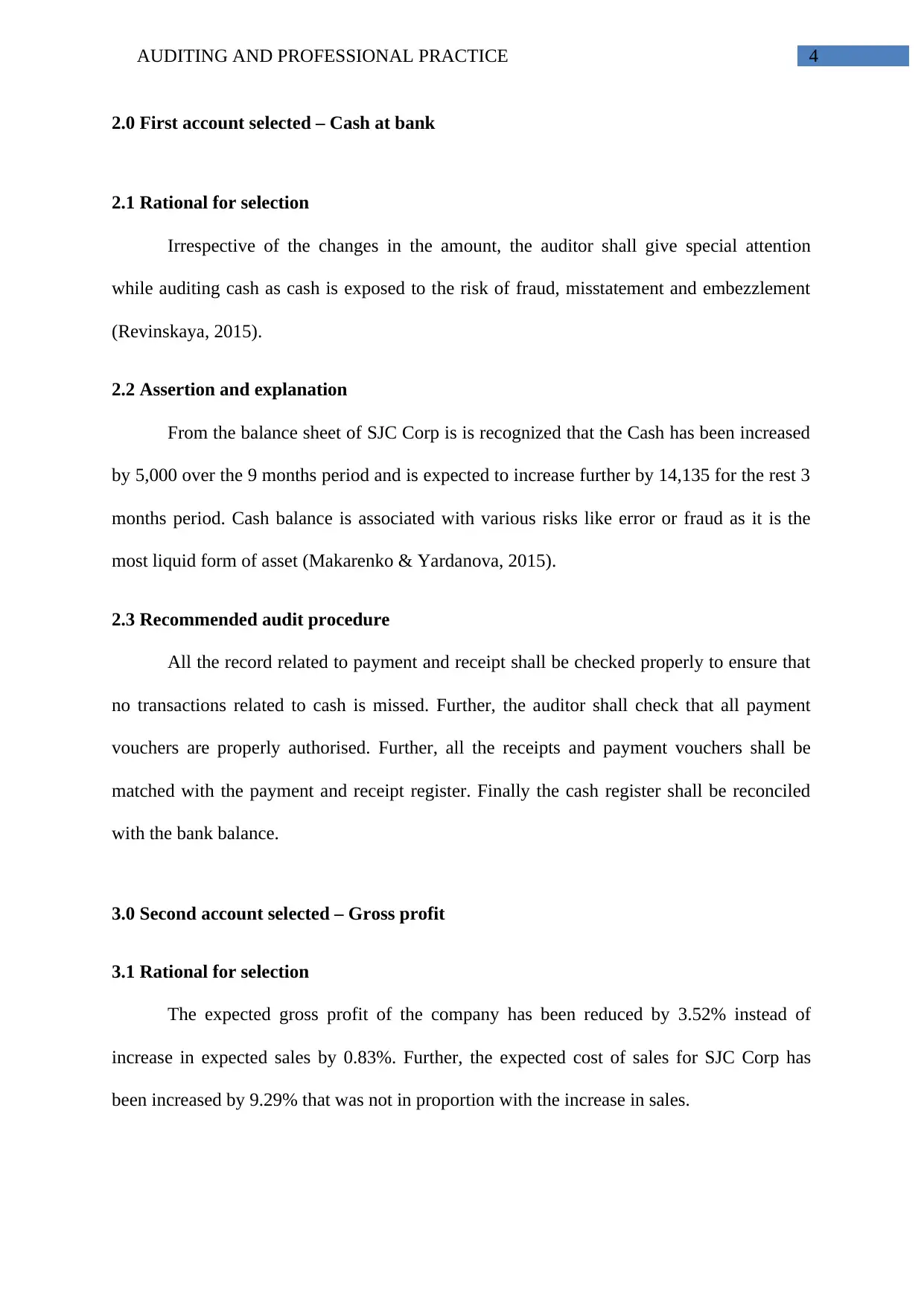
AUDITING AND PROFESSIONAL PRACTICE 4
2.0 First account selected – Cash at bank
2.1 Rational for selection
Irrespective of the changes in the amount, the auditor shall give special attention
while auditing cash as cash is exposed to the risk of fraud, misstatement and embezzlement
(Revinskaya, 2015).
2.2 Assertion and explanation
From the balance sheet of SJC Corp is is recognized that the Cash has been increased
by 5,000 over the 9 months period and is expected to increase further by 14,135 for the rest 3
months period. Cash balance is associated with various risks like error or fraud as it is the
most liquid form of asset (Makarenko & Yardanova, 2015).
2.3 Recommended audit procedure
All the record related to payment and receipt shall be checked properly to ensure that
no transactions related to cash is missed. Further, the auditor shall check that all payment
vouchers are properly authorised. Further, all the receipts and payment vouchers shall be
matched with the payment and receipt register. Finally the cash register shall be reconciled
with the bank balance.
3.0 Second account selected – Gross profit
3.1 Rational for selection
The expected gross profit of the company has been reduced by 3.52% instead of
increase in expected sales by 0.83%. Further, the expected cost of sales for SJC Corp has
been increased by 9.29% that was not in proportion with the increase in sales.
2.0 First account selected – Cash at bank
2.1 Rational for selection
Irrespective of the changes in the amount, the auditor shall give special attention
while auditing cash as cash is exposed to the risk of fraud, misstatement and embezzlement
(Revinskaya, 2015).
2.2 Assertion and explanation
From the balance sheet of SJC Corp is is recognized that the Cash has been increased
by 5,000 over the 9 months period and is expected to increase further by 14,135 for the rest 3
months period. Cash balance is associated with various risks like error or fraud as it is the
most liquid form of asset (Makarenko & Yardanova, 2015).
2.3 Recommended audit procedure
All the record related to payment and receipt shall be checked properly to ensure that
no transactions related to cash is missed. Further, the auditor shall check that all payment
vouchers are properly authorised. Further, all the receipts and payment vouchers shall be
matched with the payment and receipt register. Finally the cash register shall be reconciled
with the bank balance.
3.0 Second account selected – Gross profit
3.1 Rational for selection
The expected gross profit of the company has been reduced by 3.52% instead of
increase in expected sales by 0.83%. Further, the expected cost of sales for SJC Corp has
been increased by 9.29% that was not in proportion with the increase in sales.
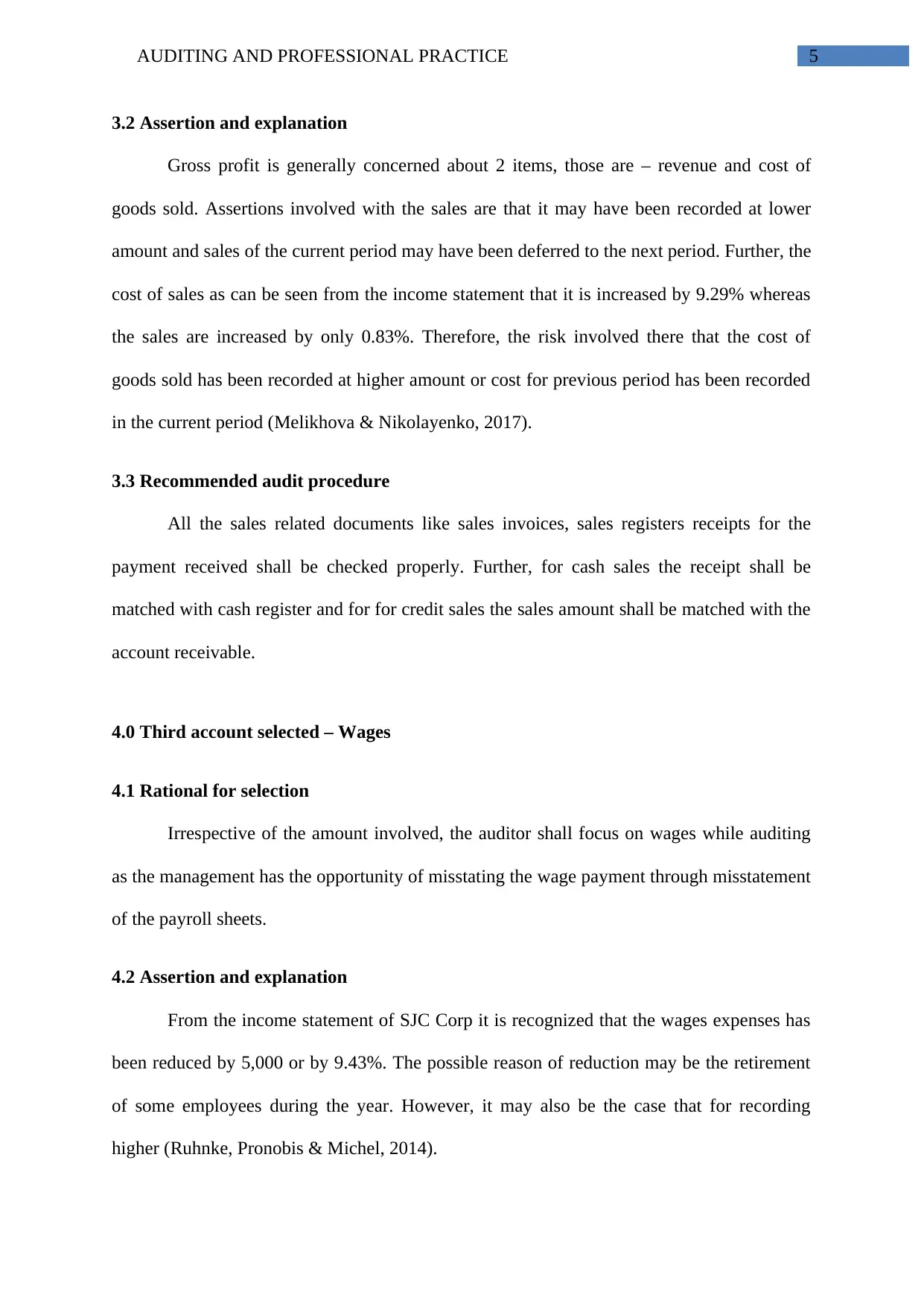
AUDITING AND PROFESSIONAL PRACTICE 5
3.2 Assertion and explanation
Gross profit is generally concerned about 2 items, those are – revenue and cost of
goods sold. Assertions involved with the sales are that it may have been recorded at lower
amount and sales of the current period may have been deferred to the next period. Further, the
cost of sales as can be seen from the income statement that it is increased by 9.29% whereas
the sales are increased by only 0.83%. Therefore, the risk involved there that the cost of
goods sold has been recorded at higher amount or cost for previous period has been recorded
in the current period (Melikhova & Nikolayenko, 2017).
3.3 Recommended audit procedure
All the sales related documents like sales invoices, sales registers receipts for the
payment received shall be checked properly. Further, for cash sales the receipt shall be
matched with cash register and for for credit sales the sales amount shall be matched with the
account receivable.
4.0 Third account selected – Wages
4.1 Rational for selection
Irrespective of the amount involved, the auditor shall focus on wages while auditing
as the management has the opportunity of misstating the wage payment through misstatement
of the payroll sheets.
4.2 Assertion and explanation
From the income statement of SJC Corp it is recognized that the wages expenses has
been reduced by 5,000 or by 9.43%. The possible reason of reduction may be the retirement
of some employees during the year. However, it may also be the case that for recording
higher (Ruhnke, Pronobis & Michel, 2014).
3.2 Assertion and explanation
Gross profit is generally concerned about 2 items, those are – revenue and cost of
goods sold. Assertions involved with the sales are that it may have been recorded at lower
amount and sales of the current period may have been deferred to the next period. Further, the
cost of sales as can be seen from the income statement that it is increased by 9.29% whereas
the sales are increased by only 0.83%. Therefore, the risk involved there that the cost of
goods sold has been recorded at higher amount or cost for previous period has been recorded
in the current period (Melikhova & Nikolayenko, 2017).
3.3 Recommended audit procedure
All the sales related documents like sales invoices, sales registers receipts for the
payment received shall be checked properly. Further, for cash sales the receipt shall be
matched with cash register and for for credit sales the sales amount shall be matched with the
account receivable.
4.0 Third account selected – Wages
4.1 Rational for selection
Irrespective of the amount involved, the auditor shall focus on wages while auditing
as the management has the opportunity of misstating the wage payment through misstatement
of the payroll sheets.
4.2 Assertion and explanation
From the income statement of SJC Corp it is recognized that the wages expenses has
been reduced by 5,000 or by 9.43%. The possible reason of reduction may be the retirement
of some employees during the year. However, it may also be the case that for recording
higher (Ruhnke, Pronobis & Michel, 2014).
⊘ This is a preview!⊘
Do you want full access?
Subscribe today to unlock all pages.

Trusted by 1+ million students worldwide
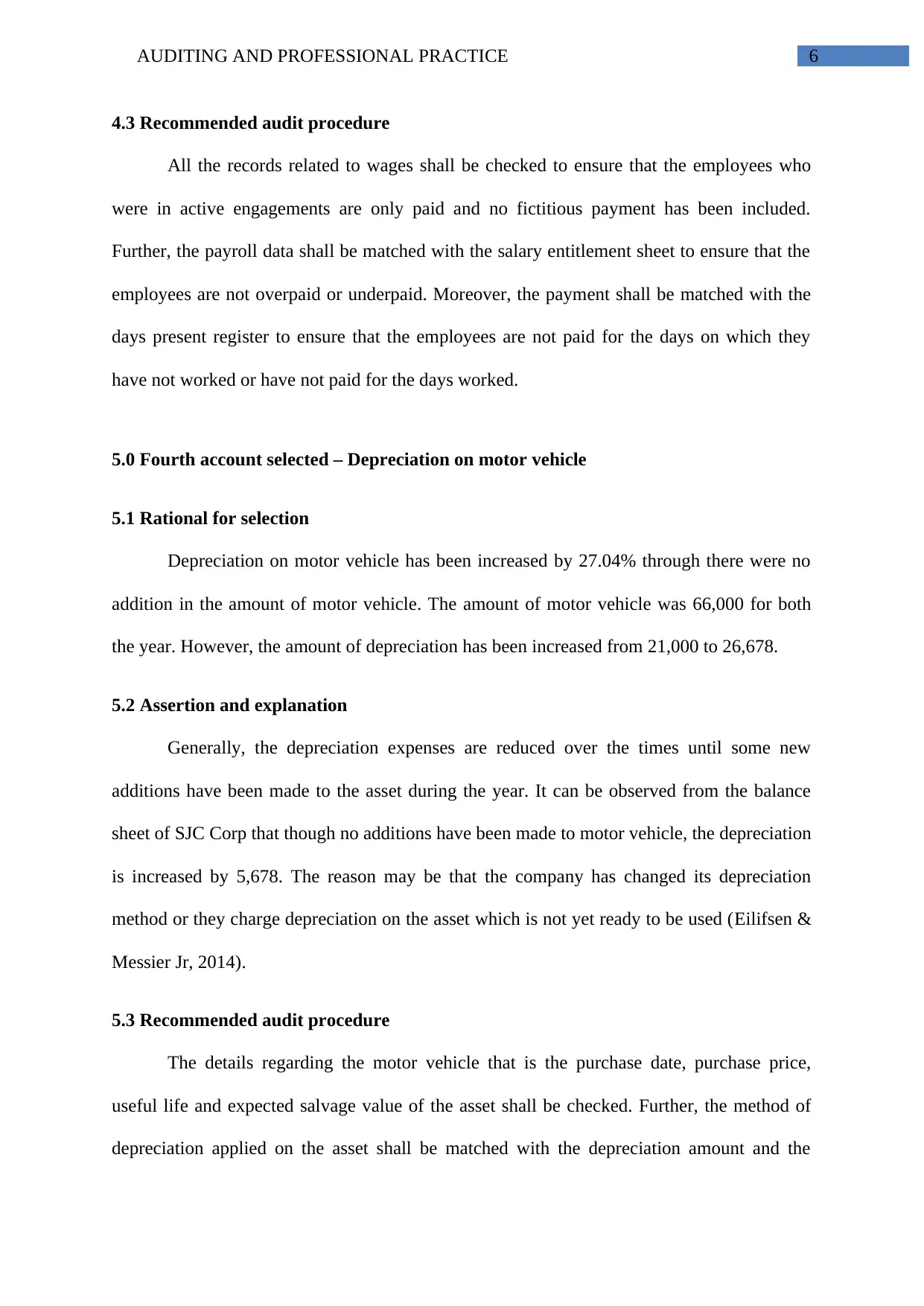
AUDITING AND PROFESSIONAL PRACTICE 6
4.3 Recommended audit procedure
All the records related to wages shall be checked to ensure that the employees who
were in active engagements are only paid and no fictitious payment has been included.
Further, the payroll data shall be matched with the salary entitlement sheet to ensure that the
employees are not overpaid or underpaid. Moreover, the payment shall be matched with the
days present register to ensure that the employees are not paid for the days on which they
have not worked or have not paid for the days worked.
5.0 Fourth account selected – Depreciation on motor vehicle
5.1 Rational for selection
Depreciation on motor vehicle has been increased by 27.04% through there were no
addition in the amount of motor vehicle. The amount of motor vehicle was 66,000 for both
the year. However, the amount of depreciation has been increased from 21,000 to 26,678.
5.2 Assertion and explanation
Generally, the depreciation expenses are reduced over the times until some new
additions have been made to the asset during the year. It can be observed from the balance
sheet of SJC Corp that though no additions have been made to motor vehicle, the depreciation
is increased by 5,678. The reason may be that the company has changed its depreciation
method or they charge depreciation on the asset which is not yet ready to be used (Eilifsen &
Messier Jr, 2014).
5.3 Recommended audit procedure
The details regarding the motor vehicle that is the purchase date, purchase price,
useful life and expected salvage value of the asset shall be checked. Further, the method of
depreciation applied on the asset shall be matched with the depreciation amount and the
4.3 Recommended audit procedure
All the records related to wages shall be checked to ensure that the employees who
were in active engagements are only paid and no fictitious payment has been included.
Further, the payroll data shall be matched with the salary entitlement sheet to ensure that the
employees are not overpaid or underpaid. Moreover, the payment shall be matched with the
days present register to ensure that the employees are not paid for the days on which they
have not worked or have not paid for the days worked.
5.0 Fourth account selected – Depreciation on motor vehicle
5.1 Rational for selection
Depreciation on motor vehicle has been increased by 27.04% through there were no
addition in the amount of motor vehicle. The amount of motor vehicle was 66,000 for both
the year. However, the amount of depreciation has been increased from 21,000 to 26,678.
5.2 Assertion and explanation
Generally, the depreciation expenses are reduced over the times until some new
additions have been made to the asset during the year. It can be observed from the balance
sheet of SJC Corp that though no additions have been made to motor vehicle, the depreciation
is increased by 5,678. The reason may be that the company has changed its depreciation
method or they charge depreciation on the asset which is not yet ready to be used (Eilifsen &
Messier Jr, 2014).
5.3 Recommended audit procedure
The details regarding the motor vehicle that is the purchase date, purchase price,
useful life and expected salvage value of the asset shall be checked. Further, the method of
depreciation applied on the asset shall be matched with the depreciation amount and the
Paraphrase This Document
Need a fresh take? Get an instant paraphrase of this document with our AI Paraphraser

AUDITING AND PROFESSIONAL PRACTICE 7
auditor must ensure that the method is consistently applied all over the year. If the method of
charging depreciation on motor vehicle has been changed from weighted average method to
diminishing balance method or from diminishing balance method to weighted average
method then the auditor shall check for the disclosure notes.
5.0 Fifth account selected – Inventory
6.1 Rational for selection
For any kind of business, inventory is the major component. Therefore, inventory
shall be checked with more cautions as the inventory can be subjected to fraud, error or
misstatement (Legoria, Melendrez & Reynolds, 2013).
6.2 Assertion and explanation
Expected inventory of the company has been increased by 17.77%. It is expected to
be increased to 204,919 from 174,000 over the one year period from 2015 to 2016. Therefore,
chances are there that the inventory has been misstated.
6.3 Recommended procedure
The inventory shall be matched with the cost of goods sold and with the opening and
closing stock. Further, the method of calculating the inventory shall be checked with the
amount. The auditor shall also check that the valuation method of inventory is consistently
applied for all the inventories throughout the year. Further, the purchase cost and sales price
of every item from inventory shall be matched with the inventory register.
auditor must ensure that the method is consistently applied all over the year. If the method of
charging depreciation on motor vehicle has been changed from weighted average method to
diminishing balance method or from diminishing balance method to weighted average
method then the auditor shall check for the disclosure notes.
5.0 Fifth account selected – Inventory
6.1 Rational for selection
For any kind of business, inventory is the major component. Therefore, inventory
shall be checked with more cautions as the inventory can be subjected to fraud, error or
misstatement (Legoria, Melendrez & Reynolds, 2013).
6.2 Assertion and explanation
Expected inventory of the company has been increased by 17.77%. It is expected to
be increased to 204,919 from 174,000 over the one year period from 2015 to 2016. Therefore,
chances are there that the inventory has been misstated.
6.3 Recommended procedure
The inventory shall be matched with the cost of goods sold and with the opening and
closing stock. Further, the method of calculating the inventory shall be checked with the
amount. The auditor shall also check that the valuation method of inventory is consistently
applied for all the inventories throughout the year. Further, the purchase cost and sales price
of every item from inventory shall be matched with the inventory register.
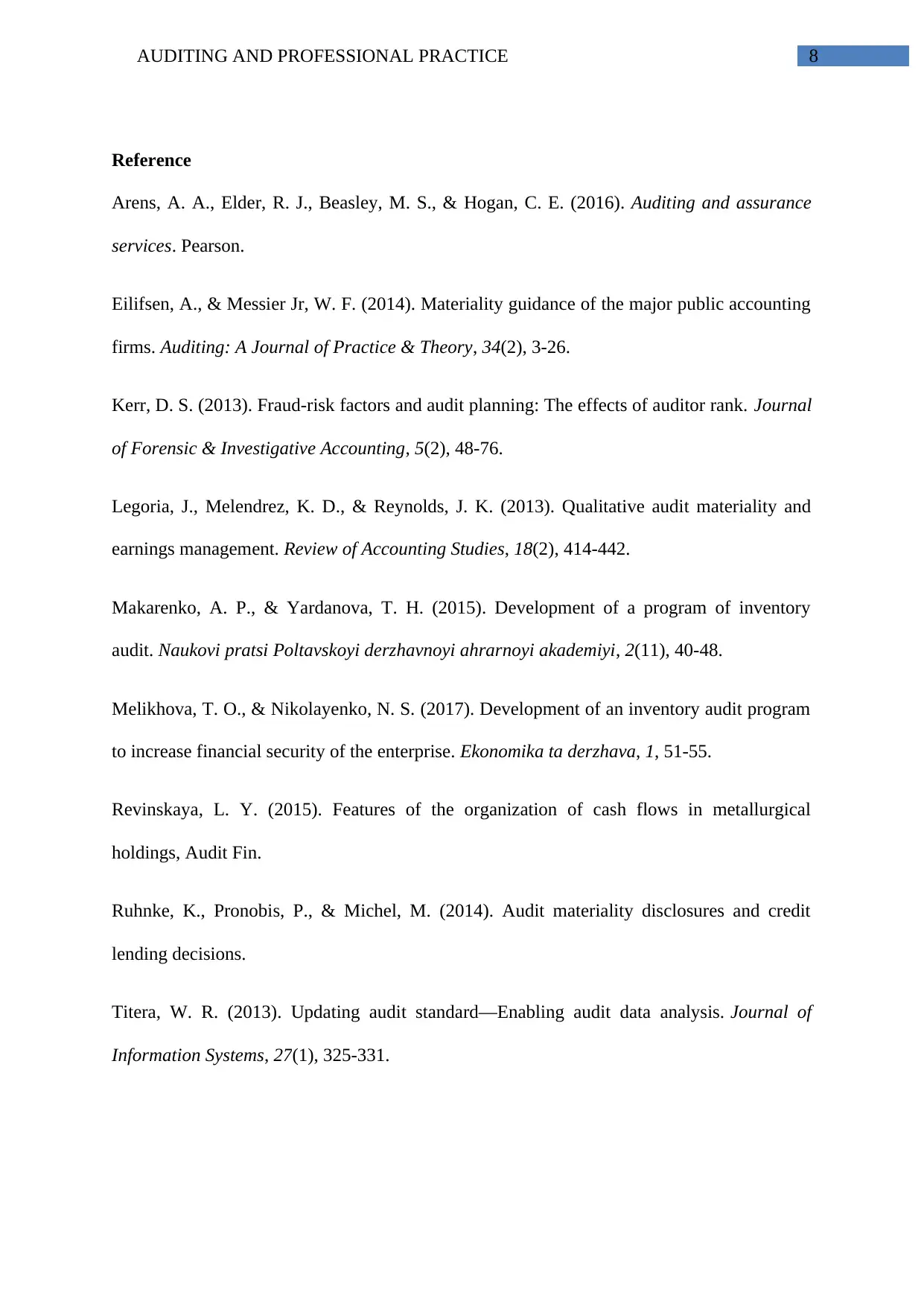
AUDITING AND PROFESSIONAL PRACTICE 8
Reference
Arens, A. A., Elder, R. J., Beasley, M. S., & Hogan, C. E. (2016). Auditing and assurance
services. Pearson.
Eilifsen, A., & Messier Jr, W. F. (2014). Materiality guidance of the major public accounting
firms. Auditing: A Journal of Practice & Theory, 34(2), 3-26.
Kerr, D. S. (2013). Fraud-risk factors and audit planning: The effects of auditor rank. Journal
of Forensic & Investigative Accounting, 5(2), 48-76.
Legoria, J., Melendrez, K. D., & Reynolds, J. K. (2013). Qualitative audit materiality and
earnings management. Review of Accounting Studies, 18(2), 414-442.
Makarenko, A. P., & Yardanova, T. H. (2015). Development of a program of inventory
audit. Naukovi pratsi Poltavskoyi derzhavnoyi ahrarnoyi akademiyi, 2(11), 40-48.
Melikhova, T. O., & Nikolayenko, N. S. (2017). Development of an inventory audit program
to increase financial security of the enterprise. Ekonomika ta derzhava, 1, 51-55.
Revinskaya, L. Y. (2015). Features of the organization of cash flows in metallurgical
holdings, Audit Fin.
Ruhnke, K., Pronobis, P., & Michel, M. (2014). Audit materiality disclosures and credit
lending decisions.
Titera, W. R. (2013). Updating audit standard—Enabling audit data analysis. Journal of
Information Systems, 27(1), 325-331.
Reference
Arens, A. A., Elder, R. J., Beasley, M. S., & Hogan, C. E. (2016). Auditing and assurance
services. Pearson.
Eilifsen, A., & Messier Jr, W. F. (2014). Materiality guidance of the major public accounting
firms. Auditing: A Journal of Practice & Theory, 34(2), 3-26.
Kerr, D. S. (2013). Fraud-risk factors and audit planning: The effects of auditor rank. Journal
of Forensic & Investigative Accounting, 5(2), 48-76.
Legoria, J., Melendrez, K. D., & Reynolds, J. K. (2013). Qualitative audit materiality and
earnings management. Review of Accounting Studies, 18(2), 414-442.
Makarenko, A. P., & Yardanova, T. H. (2015). Development of a program of inventory
audit. Naukovi pratsi Poltavskoyi derzhavnoyi ahrarnoyi akademiyi, 2(11), 40-48.
Melikhova, T. O., & Nikolayenko, N. S. (2017). Development of an inventory audit program
to increase financial security of the enterprise. Ekonomika ta derzhava, 1, 51-55.
Revinskaya, L. Y. (2015). Features of the organization of cash flows in metallurgical
holdings, Audit Fin.
Ruhnke, K., Pronobis, P., & Michel, M. (2014). Audit materiality disclosures and credit
lending decisions.
Titera, W. R. (2013). Updating audit standard—Enabling audit data analysis. Journal of
Information Systems, 27(1), 325-331.
⊘ This is a preview!⊘
Do you want full access?
Subscribe today to unlock all pages.

Trusted by 1+ million students worldwide
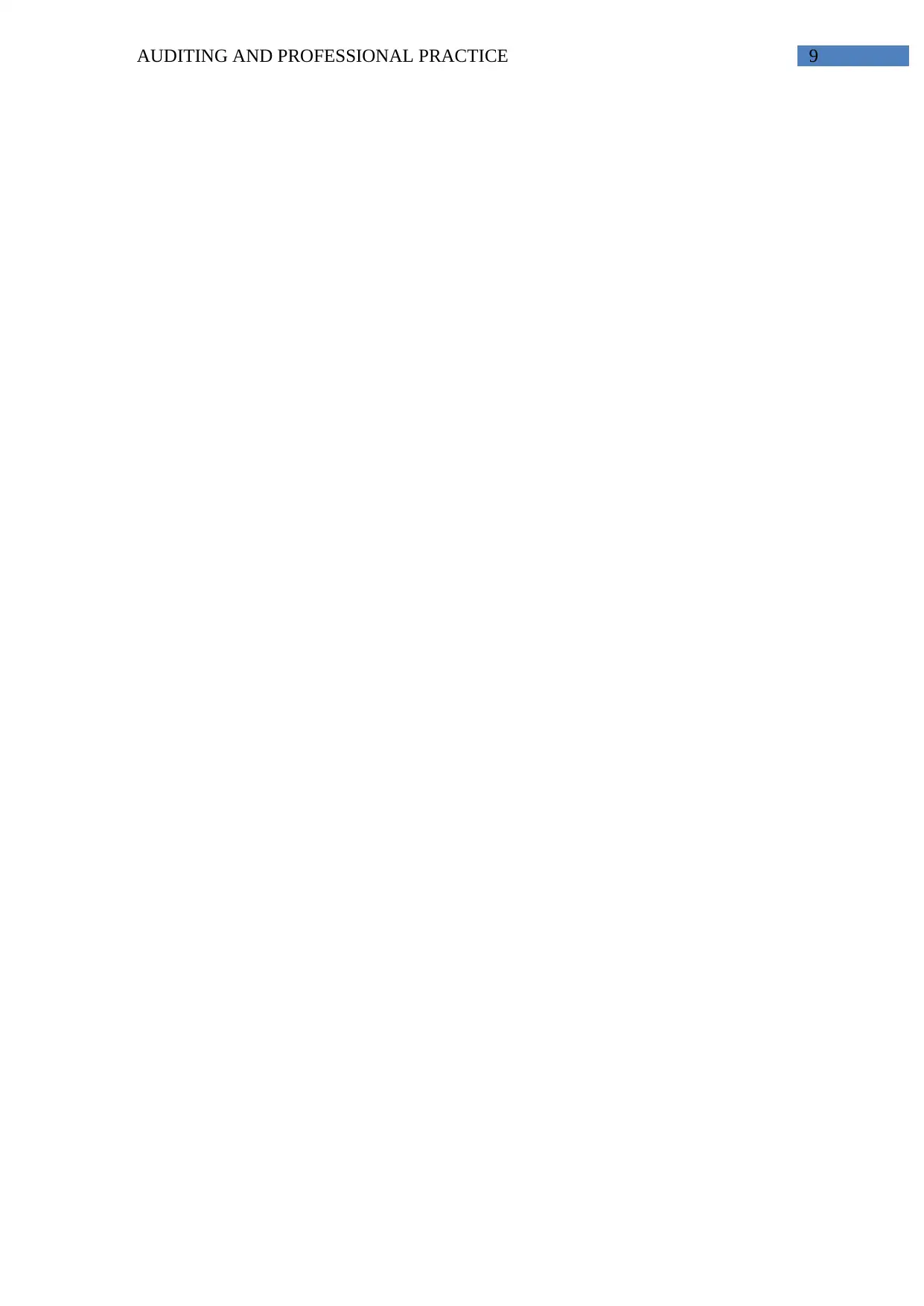
AUDITING AND PROFESSIONAL PRACTICE 9
1 out of 10
Related Documents
Your All-in-One AI-Powered Toolkit for Academic Success.
+13062052269
info@desklib.com
Available 24*7 on WhatsApp / Email
![[object Object]](/_next/static/media/star-bottom.7253800d.svg)
Unlock your academic potential
Copyright © 2020–2025 A2Z Services. All Rights Reserved. Developed and managed by ZUCOL.



